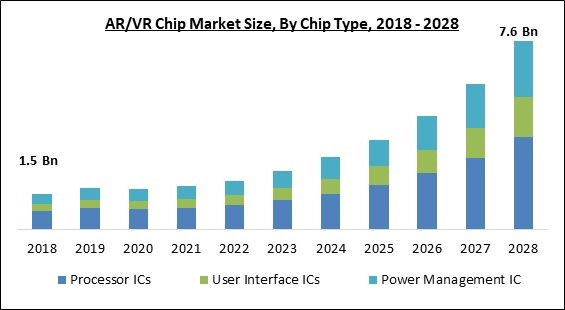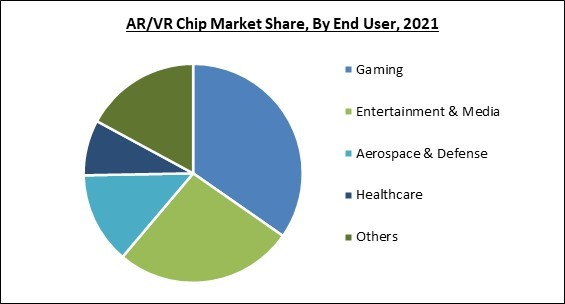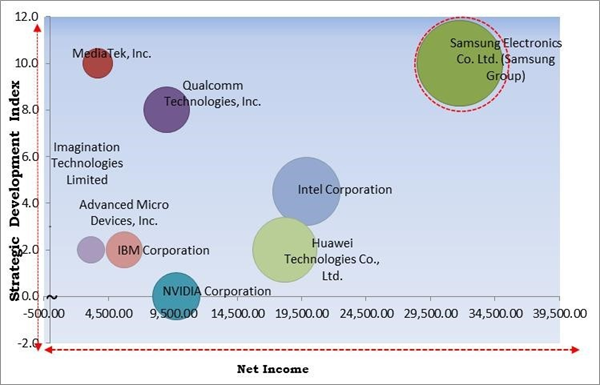The Global AR/VR Chip Market size is expected to reach $7.6 billion by 2028, rising at a market growth of 25.4% CAGR during the forecast period.
The sensory information that is superimposed may be harmful or beneficial, adding to or subtracting from the natural environment. This experience is so completely integrated with the real world that it appears to be a realistic component of the setting. In contrast to virtual reality, which substitutes the user's real-world surroundings with a simulated one, augmented reality modifies one's continuous perspective of a real environment.
Mixed reality and computer-mediated reality are words that are related to augmented reality and are mostly interchangeable. A simulated experience known as virtual reality (VR) can be quite similar to or very dissimilar from the actual world. Virtual reality has applications in business, education (such as healthcare or military training), and entertainment especially video games such as virtual meetings.
Augmented reality and mixed reality, sometimes known as extended reality or XR, are further different forms of VR-style technology. Present-day standard virtual reality systems either employ virtual reality headsets or multi-projected environments to deliver convincing sights, audio, and other sensations that simulate a user's physical presence in a virtual world.
A user can see around the virtual world, move within it, and interact with virtual features or objects while utilizing virtual reality technology. The impression can also be produced by specially built rooms with numerous large screens, although it is most frequently produced by VR headsets that have a head-mounted display with a small screen in front of the eyes. Virtual reality normally includes audio and visual feedback, but haptic technology may also enable additional types of sensory and force feedback.
The major strategies followed by the market participants are Product Launches and Partnerships. Based on the Analysis presented in the Cardinal matrix; Samsung Electronics Co. Ltd. are the forerunners in the AR/VR Chip Market. Companies such as Intel Corporation, Huawei Technologies Co., Ltd. and NVIDIA Corporation are some of the key innovators in AR/VR Chip Market.
The market research report covers the analysis of key stake holders of the market. Key companies profiled in the report include IBM Corporation, NVIDIA Corporation, Intel Corporation, Samsung Electronics Co., Ltd. (Samsung Group), QUALCOMM Incorporated (Qualcomm Technologies, Inc.), Spectra7 Microsystems Inc., MediaTek, Inc., Huawei Technologies Co., Ltd. (Huawei Investment & Holding Co., Ltd.), Advanced Micro Devices, Inc., and Imagination Technologies Limited.
The sensory information that is superimposed may be harmful or beneficial, adding to or subtracting from the natural environment. This experience is so completely integrated with the real world that it appears to be a realistic component of the setting. In contrast to virtual reality, which substitutes the user's real-world surroundings with a simulated one, augmented reality modifies one's continuous perspective of a real environment.
Mixed reality and computer-mediated reality are words that are related to augmented reality and are mostly interchangeable. A simulated experience known as virtual reality (VR) can be quite similar to or very dissimilar from the actual world. Virtual reality has applications in business, education (such as healthcare or military training), and entertainment especially video games such as virtual meetings.
Augmented reality and mixed reality, sometimes known as extended reality or XR, are further different forms of VR-style technology. Present-day standard virtual reality systems either employ virtual reality headsets or multi-projected environments to deliver convincing sights, audio, and other sensations that simulate a user's physical presence in a virtual world.
A user can see around the virtual world, move within it, and interact with virtual features or objects while utilizing virtual reality technology. The impression can also be produced by specially built rooms with numerous large screens, although it is most frequently produced by VR headsets that have a head-mounted display with a small screen in front of the eyes. Virtual reality normally includes audio and visual feedback, but haptic technology may also enable additional types of sensory and force feedback.
COVID-19 Impact Analysis
After COVID-19 spread, semiconductor businesses moved swiftly to secure supply chains, safeguard staff, and take care of other pressing issues. Even if the situation is critical and numerous governments still demand physical separation restrictions, semiconductor firms are prepared for the time when the pandemic ends and a new normal sets in. Numerous essential elements of the industry have changed as a result of COVID-19, including client behavior, business revenue, and numerous areas of corporate operations. Therefore, some businesses might not be able to endure the crisis.Market Growth Factors
Increasing Demand For AR In E-Commerce And Retail
Due to the pandemic, online purchasing has suddenly become more popular. Virtual try-on for jewelry and cosmetics enabled shoppers to determine whether the items were a good fit for them in place of many websites' disabled return policies during the pandemic. The convenience will increase demand in this sector, which will in turn help to fuel the growth of the augmented reality market. The shopping applications Loreal and Lenskart, which let users virtually try on cosmetics and judge how a pair of glasses might appear on them, respectively, are two well-known examples of augmented reality in the e-commerce industry.Enterprise Applications Present Opportunities
There is a tone of chances in enterprise applications. A key factor in the enterprise industry's growth in the AR market will be significant expenditures made by businesses in smart manufacturing. Companies with operations scattered across the nation can implement AR and hire a few engineers to manage a large setup. By using AR technology to remotely manage equipment and other installations, organizations could be run more successfully through remote collaboration. Enterprise AR has further major uses concerning the educational usage for engineers and other staff members in businesses.Market Restraining Factors
Health Problems Linked To Prolonged AR Use
Gamers are becoming more concerned about AR-related health risks as new gaming hardware and software become available. AR games are very involved and keep players hooked for extended periods, which can lead to problems including anxiety, eye strain, obesity, and loss of attention. Due to the immersive nature of AR technology, prolonged use of the AR headset may cause anxiety or stress. Users of AR gadgets are also exposed to dangerous electromagnetic frequency radiation, which can lead to disease in addition to stress.Chip Type Outlook
Based on the Chip Type, the AR/VR Chip Market is segmented into Processor ICs, User Interface ICs, and Power Management IC. The Processor ICs segment acquired the highest revenue share in the AR/VR chip market in 2021. Logic circuitry on an integrated circuit that analyzes data and instructions in a computer is referred to as a processor in general. The processor receives data and instructions, processes the data following the instructions, and calculates an output that is either utilized to manage the computer or device or finish a particular task.Device Type Outlook
On the basis of Device Type, the AR/VR Chip Market is divided into Head Mounted Display, Gesture Tracking devices, Projector & Display Wall, Head Up Display, and Handheld Device. The head up display segment witnessed a promising revenue share in the AR/VR chip market in 2021. A head-up display, commonly referred to as a heads-up display or HUD, is any transparent display that shows data without needing viewers to change their natural viewing angles.End-User Outlook
By End-user, the AR/VR Chip Market is classified into Gaming, Entertainment & Media, Aerospace & Defense, Healthcare, and Others. The entertainment & media segment registered a significant revenue share in the AR/VR chip market in 2021. AR has been successfully applied in PR and marketing campaigns for motion pictures, broadcasts, and other media promotional campaigns for entertainment purposes. Typically, these have involved printed graphics or actual object recognition, in which computer or smartphone software recognizes a special sign.Regional Outlook
Region-wise, the AR/VR Chip Market is analyzed across North America, Europe, Asia Pacific, and LAMEA. The Asia Pacific region acquired the largest revenue share in the AR/VR chip market in 2021. It is because countries focus on training, medical support, and online learning for consumers using virtual reality technology, that the Asia Pacific region was quite significant. However, nations like India are still on the cusp of beginning to adopt new technologies and incorporate them into various industries, which also suggests that the region would experience a faster development rate in the virtual reality market over the projection period.Cardinal Matrix-AR/VR Chip Market Competition Analysis
The major strategies followed by the market participants are Product Launches and Partnerships. Based on the Analysis presented in the Cardinal matrix; Samsung Electronics Co. Ltd. are the forerunners in the AR/VR Chip Market. Companies such as Intel Corporation, Huawei Technologies Co., Ltd. and NVIDIA Corporation are some of the key innovators in AR/VR Chip Market.
The market research report covers the analysis of key stake holders of the market. Key companies profiled in the report include IBM Corporation, NVIDIA Corporation, Intel Corporation, Samsung Electronics Co., Ltd. (Samsung Group), QUALCOMM Incorporated (Qualcomm Technologies, Inc.), Spectra7 Microsystems Inc., MediaTek, Inc., Huawei Technologies Co., Ltd. (Huawei Investment & Holding Co., Ltd.), Advanced Micro Devices, Inc., and Imagination Technologies Limited.
Strategies deployed in AR/VR Chip Market
Partnerships, Collaborations and Agreements:
- Jul-2022: MediaTek came into a partnership with Intel Foundry Services, an American international company. Together, the companies aimed to create the next-era smart device chips. Additionally, the partnership allows the company to expand its offering of processors for the internet of things (IoT) market, as well as make certain it has a supply of those new chips to market.
- Jan-2022: Qualcomm Technologies joined hands with Microsoft, an American multinational technology corporation. Through this collaboration, the companies aimed to develop and boost the adoption of augmented reality (AR) in both the customer and business sectors. Additionally, the collaboration acknowledges Qualcomm Technologies’ proven spatial technology leadership, computing expertise, and passion to produce transformative experiences for the next era of head-worn AR devices as the company head into the metaverse.
- Jan-2022: AMD came into a partnership with Samsung, one of the world's biggest producers of electronic devices. Together, the companies aimed to leverage Exynos 2200 chip with AMD RDNA 2 architecture-based Samsung Xclipse graphic processing unit (GPU). Moreover, AMD’s graphics advancements, the Xclipse GPU delivers hardware boosted ray tracing (RT) and variable rate shading (VRS), formerly available on laptops and personal computers.
- Nov-2021: IBM came into a partnership with Neureality, an innovative semiconductor startup. Through this acquisition, NeuReality has evolved into a member of the IBM Research AI Hardware Center and licensee of the Center’s low-precision high-performance Digital AI Cores. Moreover, IBM would estimate NeuReality’s products for utilization in IBM’s Hybrid Cloud, such as AI use cases, virtualization, system flows, security, networking and more.
- Feb-2020: Intel Ireland teamed up with Technological University Dublin, Ireland's first technological university. Together the entities would explore the utilization of Virtual Reality (VR) technologies for training simulation programs in Intel. Additionally, the partnership would visit Intel to engage the expertise of a field of emerging technologies known from the Virtual Interaction Research Lab (VIRaL) and School of Media at TU Dublin.
Product Launches and Product Expansions:
- Aug-2022: Samsung introduced artificial muscle actuators for immersive VR and AR. The new project utilizes packed artificial muscle actuators to allow quick image focus in AR/VR and tactile feedback for VR controls.
- Aug-2022: MediaTek introduced Pentonic 700 chipset for mainstream CTVs. The new Pentonic 700 is also developed with gaming sense, as it supports variable refresh rate (VRR) up to 144Hz to give brands the capability to personalized TVs for gaming applications so parties can enjoy games without screen stuttering and tearing.
- May-2022: MediaTek introduced Filogic 880 and Filogic 380, World's First Complete Wi-Fi 7 Platforms for Access Points and Clients. The new Filogic 880 and Filogic 380 would propel the next era of connectivity with the quickest and most dedicated Wi-Fi 7 experiences. Additionally, Wi-Fi 7 technology would be the spine of office, home, and industrial networks and deliver seamless connectivity for everything from multi-player AR/VR applications to cloud gaming along with 4K calls to 8K live streaming and beyond.
- Mar-2022: Imagination Tech unveiled Open Source PowerVR Vulkan Driver for Mesa. The new Mesa Vulkan is founded on the open-source RADV Radeon Vulkan driver and can be utilized with both their latest PowerVR kernel driver and the PVRSRVMKM kernel driver provided with their development tools.
- Feb-2022: Samsung Electronics launched an augmented reality (AR) device that would be advanced with hologram technology. The new AR device would run on the company's Exynos application processor (AP) and the Google Android OS. Additionally, Samsung Electronics, Meta, Apple, and Microsoft are contending for a share of the burgeoning metaverse device industry.
- Nov-2021: Qualcomm Technologies launched Snapdragon Spaces XR Developer Platform, a head-worn Augmented Reality (AR) developer kit. The new Spaces XR allows the design of enveloping experiences that seamlessly obscure the lines between digital and physical facts. Moreover, Snapdragon Spaces delivers powerful machine perception technology that is designed for performance and low power for the next era of AR glasses.
Mergers & Acquisition
- Feb-2022: Harman International, Samsung Electronics' subsidiary completed the acquisition of Apostera, a Germany-based mixed reality developer. With this acquisition, Apostera's mixed reality solution incorporates Machine Learning, Augmented Reality, Computer Vision, and sensor fusion in a hardware-agnostic software medium.
Scope of the Study
Market Segments Covered in the Report:
By Device Type
- Head Mounted Display
- Gesture Tracking Device
- Projector & Display Wall
- Head Up Display
- Handheld Device
By End User
- Gaming
- Entertainment & Media
- Aerospace & Defense
- Healthcare
- Others
By Chip Type
- Processor ICs
- User Interface ICs
- Power Management IC
By Geography
- North America
- US
- Canada
- Mexico
- Rest of North America
- Europe
- Germany
- UK
- France
- Russia
- Spain
- Italy
- Rest of Europe
- Asia Pacific
- China
- Japan
- India
- South Korea
- Singapore
- Malaysia
- Rest of Asia Pacific
- LAMEA
- Brazil
- Argentina
- UAE
- Saudi Arabia
- South Africa
- Nigeria
- Rest of LAMEA
Key Market Players
List of Companies Profiled in the Report:
- IBM Corporation
- NVIDIA Corporation
- Intel Corporation
- Samsung Electronics Co., Ltd. (Samsung Group)
- QUALCOMM Incorporated (Qualcomm Technologies, Inc.)
- Spectra7 Microsystems Inc.
- MediaTek, Inc.
- Huawei Technologies Co., Ltd. (Huawei Investment & Holding Co., Ltd.)
- Advanced Micro Devices, Inc.
- Imagination Technologies Limited
Unique Offerings from the Publisher
- Exhaustive coverage
- The highest number of Market tables and figures
- Subscription-based model available
- Guaranteed best price
- Assured post sales research support with 10% customization free
Table of Contents
Chapter 1. Market Scope & Methodology
Chapter 2. Market Overview
Chapter 3. Competition Analysis - Global
Chapter 4. Global AR/VR Chip Market by Device Type
Chapter 5. Global AR/VR Chip Market by End User
Chapter 6. Global AR/VR Chip Market by Chip Type
Chapter 7. Global AR/VR Chip Market by Region
Chapter 8. Company Profiles
Companies Mentioned
- IBM Corporation
- NVIDIA Corporation
- Intel Corporation
- Samsung Electronics Co., Ltd. (Samsung Group)
- QUALCOMM Incorporated (Qualcomm Technologies, Inc.)
- Spectra7 Microsystems Inc.
- MediaTek, Inc.
- Huawei Technologies Co., Ltd. (Huawei Investment & Holding Co., Ltd.)
- Advanced Micro Devices, Inc.
- Imagination Technologies Limited
Methodology

LOADING...











